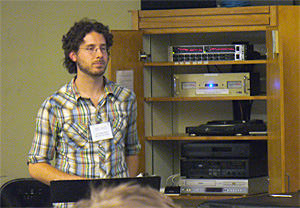 |
| Ian Dahlman of Ryerson and York Universities presents his paper on indie rock band Broken Social Scene (Ryan McNutt photo) |
Whether itвҖҷs blasting out of a stereo or pumping through a pair of headphones, music surrounds us every day. ItвҖҷs no wonder, then, that there are many academic researchers interested in popular music not only as form and structure, but as a way of better understanding our societyвҖҷs politics, economics and culture.
This past weekend, dozens of professors and graduate students gathered at В鶹ҙ«ГҪ for the 2009 Canadian conference of the International Association for the Study of Popular Music (IASPM). They came from a wide variety of research backgrounds вҖ“ from popular culture to musicology to fine arts вҖ“ but all shared an interest in studying the soundtrack of our lives.
The topics discussed were as wide-ranging as the most eclectic iTunes playlist. Barry Promane of the University of Western Ontario used Queen to explore rock and rollвҖҷs relationship with the AIDS crisis and homophobiaВ in the 1980s. Nicholas Greco of Providence College and Seminary analyzed FeistвҖҷs I Feel It All in the context of literary theorist Roland BarthesвҖҷ concept of вҖңcruisingвҖқ the text. And Barbara Ching of the University of Memphis delved into how song collecting вҖ“ or вҖңsongcatchingвҖқ вҖ“ is changing in the digital age.
But doesnвҖҷt talking about music in such a fashion miss the point? IsnвҖҷt it just, as itвҖҷs famously been described, вҖңdancing about architecture?вҖқ
вҖңWhatвҖҷs so wrong with dancing about architecture?вҖқ asks Jacqueline Warwick, assistant professor in the Department of Music and chair of the local arrangements committee for the conference. вҖңWe can learn a great deal from talking about music and why people care about it. There is such an emotional connection there that, whether itвҖҷs from an historical or a cultural perspective, we can learn a quite a lot.вҖқ
Over a dozen faculty, staff and students from В鶹ҙ«ГҪ were involved in putting the conference together, which was titled вҖңGoing Coastal: Peripheries and Centres in Popular Music.вҖқ Assistant professor Steven Baur also was a presenter at the conference with a paper exploring class dynamics of 19th century blackface minstrel shows.В
Two student papers received special prizes from conference organizers. The first, by Tara Rodgers of McGill University, surveyed 19th- and early 20th-century literature on sound production to better understand the evolution of our conceptualization of sound forms. The second, by Ian Dahlman of Ryerson and York Universities, used the indie rock band Broken Social Scene as a case study to evaluate collectivist models of band membership.
вҖңWhat really drove me to explore [the topic] was actually the bandвҖҷs self-titled album, because I felt you could feel all the ruptures and breaks and cracks,вҖқ said Mr. Dahlman. вҖңIt didnвҖҷt seem like it was always necessarily a happy, utopian place but actually something that was constantly in flux and had its own share of anxiety, fear and love. It was collecting the emotion of all these constantly-shoving people in one project.вҖқ
The conference was a good fit for В鶹ҙ«ГҪ, which earlier this year launched the first masters program in musicology in the Maritimes. The degree program, which admits its first students this fall, allows students to investigate musicвҖҷs role and meaning in various social and historical contexts.
